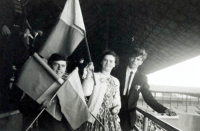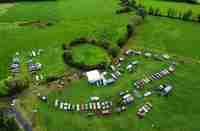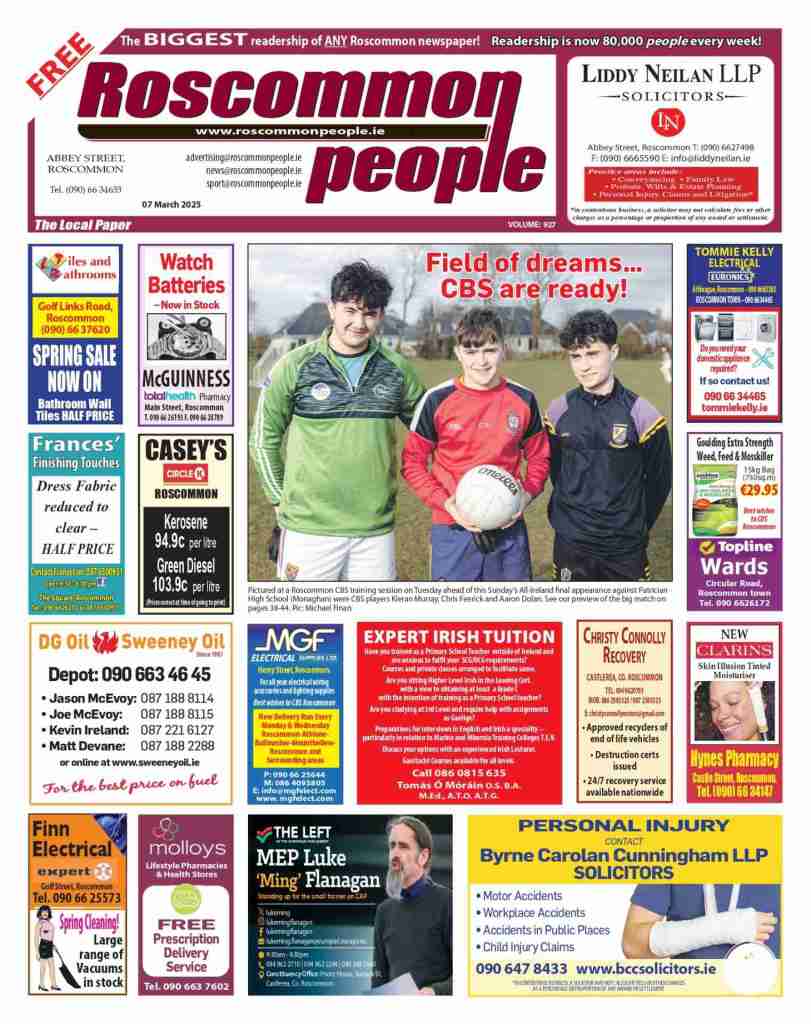EMMETT CORCORAN holds his hands up to one erroneous statement, one ambiguous statement… and takes a second pass at explaining the Seanad in briefer and most digestible terms!
With the 2025 Seanad elections approaching, there are five local candidates vying for seats in the next Seanad.
So, who is in the race locally?
Putting aside the fact that Seanad constituencies are designed to not be geographically based, instead electing members to university panels, vocational panels and allowing for 11 appointments by the Táoiseach… in Ireland, all politics is ultimately local.
NUI candidates
So, with respect to the university panels, political newcomers Hilary Beirne (Boyle) and Mairead Kenny (Donamon) are both new Seanad candidates seeking a seat on the National University of Ireland panel which is voted for by degree graduates of that institution.
Established NUI senators Ronan Mullen and Michael McDowell also have tangential links to Roscommon with the McDowell family owning a holiday home outside Rooskey.
Meanwhile, Mullen has strong ties to Ballinasloe and East Galway having been born and raised in Ahascragh, Co Galway.
Familiar faces
When it comes to the vocational panels, this is usually where we see the ‘familiar’ political faces competing on over-subscribed panels, often against the odds.
This time around, Eugene Murphy is contesting the Seanad’s Agriculture Panel with an outside nomination. While all Seanad candidates are technically ‘non-party’, Eugene is contesting the seat this time without the endorsement and affiliation of his former political party of well over 40 years, Fianna Fáil.
In recent weeks, Murphy has heavily emphasised his 40-year career in politics and points to having given up his music promotion and landscaping businesses when he was elected as a Fianna Fáil TD in 2016. He is on the record essentially saying that if he is unsuccessful in securing a Seanad seat it will mark the end of his political career, shy of retirement age, which has spanned 40 years.
Aisling Dolan is a prominent Fine Gael politician and will also be contesting the Agricultural Panel. She too has an outside nomination. A two-time General Election candidate for Fine Gael (in 2020 and again in 2024), Dolan finished 5th in 2020 and 4th in 2024.
In this competitive three-seater, Dolan has proven popular among her political party colleagues but her electoral performance and chances of taking a Dáil seat for Fine Gael appear to be entering last chance territory.
If I was to guess, given that Dolan has seen an improvement in her finishing position in the consecutive elections, and in light of her ability to toe the party line, I would imagine that if Dolan is successful in retaining a seat in the Seanad she will have a strong running mate in the northern part of the Roscommon-Galway consistency at the next General Election.
Eugene Murphy is based in Scramogue and Dolan is based in Ballinasloe. Additionally, former Fianna Fáil TD for Longford-Westmeath and Lanesboro native, Joe Flaherty is contesting the Cultural and Educational Panel with an inside nomination.
A little clarity?
Here is a clear and concise guide to how Ireland’s upper parliamentary house is structured. This article explains the vocational panels, university panels, and Taoiseach’s appointees in plain terms, focusing on how candidates qualify and seats are filled.
It is also worth noting that all candidates for the Seanad, whether affiliated to a political party or not, appear on the ballot paper without any party affiliation noted.
That’s unlike in Dáil and local elections where the registered political party the candidate is competing the election on behalf of is listed on the ballot paper (a legal requirement). Perhaps an indication of Dev’s great vision for the Seanad being “independent but not too independent”, and you’ll have to read my explainer in Roscommon People issued dated 3/1/25 to truly appreciate this comment.
Seanad panels
The Seanad’s panels were created under the 1937 Constitution to represent specific sectors of society. However, the details of how they operate – including their composition, candidate eligibility, and voting procedures – are defined by statute, particularly the Seanad Electoral (Panel Members) Act, 1947 and Seanad Electoral (University Members) Act, 1937.
There are five vocational panels with a total of 43 seats. Each panel has seats reserved for candidates nominated by two groups:
Oireachtas sub-panel (inside nominees): Candidates nominated by sitting TDs and senators.
Nominating bodies sub-panel (outside nominees): Candidates nominated by independent organisations registered with the Clerk of the Seanad.
Some panels also have ‘floating’ seats, which can be filled by candidates from either sub-panel.
Breakdown of vocational panels
1.Administrative panel (7 seats)
Inside nominees: 3 (at least)
Outside nominees: 3 (at least)
Floating seats: 1
(Represents public administration and social services)
2.Agricultural panel (11 seats)
*Inside nominees: 4
*Outside nominees: 4
*Floating seats: 3
(Represents agriculture and fisheries)
3.Cultural and educational panel (5 seats)
Inside nominees: 2
Outside nominees: 2
Floating seats: 1
(Represents education, the arts, and Irish culture)
4.Industrial and commercial panel (9 seats)
Inside nominees: 3 (at least)
Outside nominees: 3 (at least)
Floating seats: 3
(Represents industry and commerce, including engineering and architecture)
5.Labour panel (11 seats)
Inside nominees: 4 (at least)
Outside nominees: 4 (at least)
Floating seats: 3
(Represents organised and unorganised labour)
Voting process
The electorate for vocational panels consists of members of the incoming Dáil, outgoing Seanad, and city and county councillors. Voting is conducted using the single transferable vote system via postal ballot. Each candidate must meet specific nomination requirements, and a quota ensures minimum representation from both inside and outside sub-panels.
University panels
In addition to the vocational panels, six senators are elected by two university constituencies:
National University of Ireland (NUI): 3 seats
University of Dublin (Trinity College Dublin): 3 seats
Candidates for these seats are not required to be graduates of the university they wish to represent; however, they must secure a proposer and seconder from registered voters in the constituency. In addition, they must secure eight additional ‘assentors’ who are registered voters from the same constituency.
Only registered graduates of the respective universities are eligible to vote.
Taoiseach’s appointees
The Taoiseach nominates 11 senators after a general election, once a new government has been formed and a new Taoiseach is elected by the Dáil. These appointments are typically used to secure a government majority in the Seanad or to represent underrepresented groups. This flexibility allows for diverse voices in the chamber. In recent times, it has become a common trend that the Taoiseach of the day will appoint a prominent member of the Northern Ireland community and/or a member of the prominent member of the Irish diaspora in the United States. In efforts to forge ties with these communities and the Republic of Ireland, this trend has been broadly welcomed by the political establishment.
A constitutional framework defined by statute
The 1937 Constitution established the Seanad as a vocational body, but the practical details of its operation are set out in legislation. The Seanad Electoral (Panel Members) Act, 1947 governs the vocational panels, while the Seanad Electoral (University Members) Act, 1937 oversees the university constituencies.
This dual structure balances representation from political insiders, independent organisations, graduates, and appointees, ensuring the Seanad remains a key forum for legislative review and debate.
What to expect in 2025
As the 2025 Seanad elections draw near, the Clerk of the Seanad is overseeing nominations and compliance with statutory requirements. Deadlines for candidate nominations across the panels have been set, with the election process expected to follow established procedures.
*Clarification on the report published on page 14 of the January 3rd edition of the Roscommon People.






